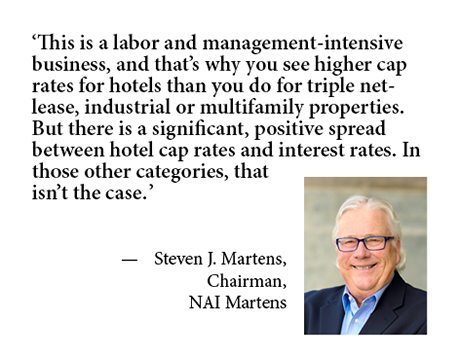For a little more than a year now, Americans have gone on a collective road trip, making up for time stolen during the lockdowns. In turn, that has fueled a rebound in the hotel industry, which was decimated in 2020 and much of 2021.
Revenue per available room (RevPAR), a key measure of hotel profitability, is expected to end 2022 at an average of $93, up nearly 8 percent versus 2019, according to a hotel forecast update in late November by STR, a hospitality research organization based in Hendersonville, Kentucky. Meanwhile, the projected average occupancy of 62.7 percent will mark an increase of 5.1 percentage points over 2021, and the estimated average daily rate (ADR) of $148 will best last year’s number by $23, STR reports.
Select service lodging properties in particular are helping to lead the recovery, says Steven J. Martens, chairman of NAI Martens, a Wichita-based commercial real estate brokerage that is one of five brands under the Martens Companies umbrella.
“The majority of the midscale and upper midscale assets are very dependent upon leisure travel, and they are seeing a rebound throughout the country,” he adds. “Most good operators with strong hotel brands have seen very healthy revenue increases in their gross room revenue through 2022, and everybody expects that to continue through 2023 despite some economic headwinds.”
Decisions Looming
Still, when adjusted for inflation, RevPAR is not expected to fully recover until 2025, STR says. To some degree, that and the beating that hotel owners took during COVID-19 is putting partnerships, limited liability companies and other private select service hotel owners into tough situations, he suggests.
Owners who were successfully executing their business plans in 2019 and saw fundamentals substantially deteriorate during the shutdown are now staring down the barrel of having to refinance. The question is, Martens says, have the hotels recovered enough to support a refinancing at an interest rate of around 6 to 6.5 percent – or close to double their cost of capital for the maturing note?
Additionally, hotel brands (or “flags”) are eagerly launching property improvement programs (PIPs) after sidelining them during the pandemic. Depending on the agreement between the owner and hotel brand, those typically require owners to invest around $5,000 a room or lose the hotel flag, Martens says. That usually results in a hotel downgrading to a lower market tier and does not end well, he adds.
“Some owners today may not have the appetite to make the additional investment for a PIP,” states Martens, who also manages and develops hospitality properties. “But the nice gains in RevPAR, occupancies and the average daily rate are now supporting purchase prices that a lot of these hotel owners should be willing to sell at. So, I think in 2023 and 2024, we’re going to see a lot of sales activity in these properties.”
In some cases, Martens also expects more visible distress to emerge in the select service sector in 2023. Although the hotels are recovering, in some cases labor and utility costs are eating into the RevPAR and ADR gains, he adds, even as operators have pocketed cost savings by carrying over the pandemic practice of ending daily room cleanings. At the same time, a challenging operating environment continues to hound hotel operators, who cannot find help or count on timely deliveries of new linens, towels and other basic supplies due to ongoing supply chain problems.
Volatility Ahead
How much interest the hotel sector can generate among buyers remains to be seen. A widely expected economic slump coupled with higher interest rates has already reined in investment sales of commercial real estate broadly. Hotel sales of nearly $37 billion through October of 2022 represented a year-over-year increase of 3 percent, according to MSCI Real Assets, a New York-based commercial real estate researcher that tracks deals of $2.5 million or more. But large transactions such as Brookfield’s $3.8 billion acquisition of Watermark Lodging Trust have been driving the activity versus single asset sales.
Martens anticipates that deal flow will remain subdued in the first half of 2023 and then pick up as inflation continues to recede and interest rates stabilize at slightly lower levels once the Federal Reserve ends its rate hikes. In addition to the rebound in leisure travel and fundamentals, the relatively high capitalization rates associated with hotels may appeal to investors. MSCI Real Assets pegged the average hotel cap rate at 8.3 percent in the third quarter.
“This is a labor and management-intensive business, and that’s why you see higher cap rates for hotels than you do for triple net-lease, industrial or multifamily properties,” Martens explains. “But there is a significant, positive spread between hotel cap rates and interest rates. In those other categories, that isn’t the case.”
Supply also favors the select service hospitality segment. In 2010, virtually every hotel flag began a roughly eight-year expansion that added new midscale and upper midscale brands to various markets, he points out. But more recently, the pandemic, inflated construction costs and higher interest rates have made it difficult to build.
“The supply side has remained pretty stable, and I think it’s going to be a good 24 months before we start to see any inventory of significance added,” Martens remarks. “It’s all a factor of how hot a local hospitality market gets. Clearly if there’s demand and the daily rates appear to be sustainable, someone will come in and build a new property.”
— By Joe Gose. This article was written in conjunction with NAI Global, a content partner of REBusinessOnline. For more articles from and news about NAI Global, click here.


